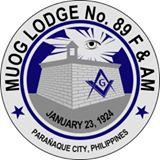
Muog Lodge No. 89
The Name
Muog is a Tagalog word signifying "bulwark," fortress", "tower of strength." This name has been applied to the town of Paranaque, because it served the Filipino patriots as a bulwark against the Spanish forces.
The Lodge
In 1923, a group of Master Masons (Sabas de Guzman, Fausto Fronda, Eulalia Monsod, Agripino Pascual, Maximo C. Hernandez, Pedro Lombos, Cipriano C.. Escasio, Tcodorico B. Santos and Eulalio D. Cruz), all residents of Paranaque, decided to disseminate the teachings of Freemasonry in the ten neighboring municipalities.
After several caucuses held at the residence of Eulalio Monsod, they held an organizational meeting on St. John's Day, June 24, 1923, in the house of Mr. Bernardo Custodio in Dongalo. The meeting was also attended by members of the following neighboring lodges: Pintong Bato Lodge No 51, Batong Buhay Lodge No. 27, Magdalo (now Gen. Emilio Aguinaldo Niemorial Lodge) No. 31; Walana Lodge No.13, Dapitan Lodge No. 21, Labong Lodge No. 59, Taga-Ilog Lodge No. 79, and High Twelve Lodge No. 82. On July 16, 1923, Grand Master Frederic H. Stevens issued a dispensation authorizing them to organize a lodge in Paranaque. The following year, on January 23, 1924, the Grand Lodge granted Muog Lodge a charter.
On March 29, 1924, Grand Master Wenceslao Trinidad, assisted by Quintin Paredes and other Masonic dignitaries, opened a Special Communication of the Grand Lodge in the Paranaque Elementary School in Paranaque, Rizal for the purpose of constituting Muog Lodge. The ceremonies were public and the attendance was in excess of the capacity of the building. After the constitution of the lodge, the officers led by the Master, Sabas de Guzman, were installed into office.
Incidentally, when the name of the lodge was considered, several were suggested, among which were "Palanyag," "Andres Bonifacio" and "Muog." After some discussion, "Muog" as suggested by Eulalio Monsod, was unanimously adopted. It was explained that whenever invading foreign troops tried to enter Manila from the South, they always met with great resistance in Parañaque, the entrance to Manila from the South. Due to the valor and tenacity of the entrance to Manila from the South. Due to the valor and tenacity of the defending troops stationed in the northern bank of the Parañque river, invaders were forced to stop at the southern bank of the river. It was said that Chinese, British, and Spanish, as well as the American, troops during the early days of Philippine history were all stalled at the foot of the Parañaque bridge before they could enter Manila due to the formidable resistance they encountered from the defenders from the other side of the Parañaque river.
During the Second World War, the Japanese troops from the South were also stopped at the Parañaque bridge and had to wait for two days before the were could proceed to Manila. Likewise, the American liberation forces coming from the South on February 5, 1945 had to establish their headquarters first in Parañaque, south of the river, and wait for days before making their march to the city.
At present holding the fort for the lodge are such Masonic stalwarts as Bibiano Fajardo, Bernard C. Bassig, Romantico S. Molato, Mario S. Santos, Sergio A. Salvador, Efren C. Valenzuela and Joel SG Lazaro.
Location :Parañaque , Metro Manila
 The Most Worshipful Grand Lodge of Free and Accepted Masons of the Philippines
The Most Worshipful Grand Lodge of Free and Accepted Masons of the Philippines